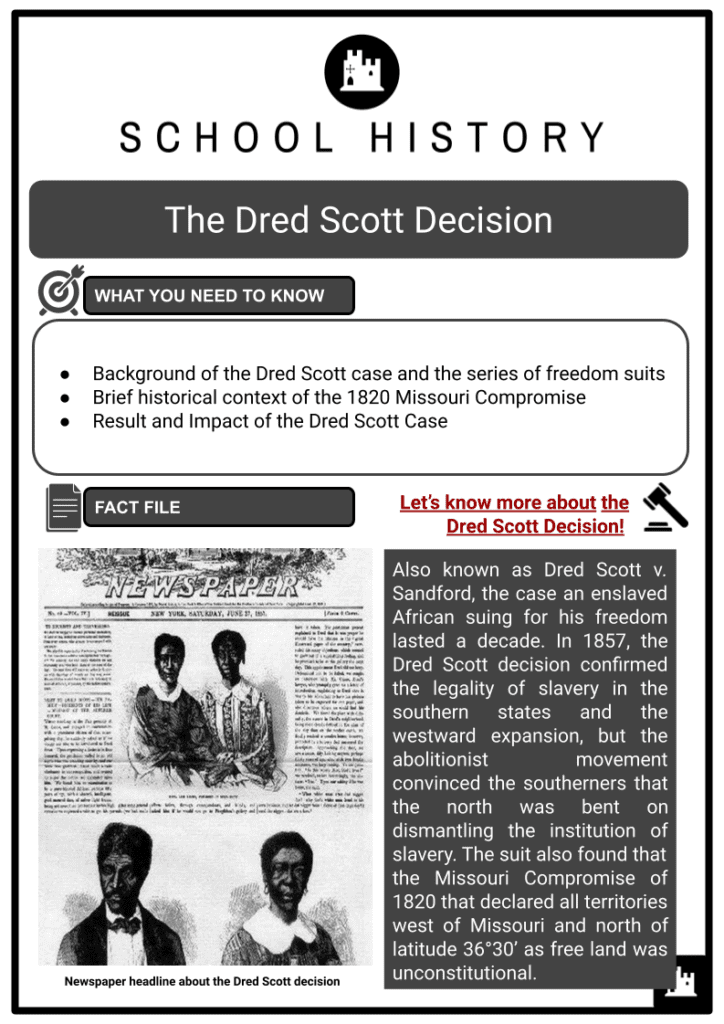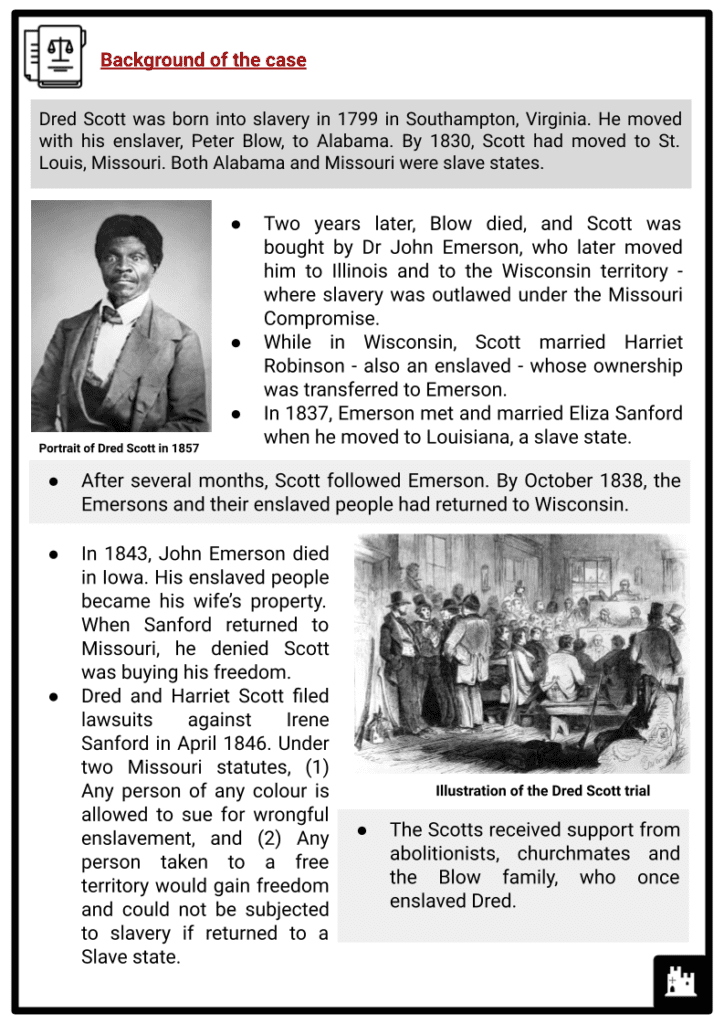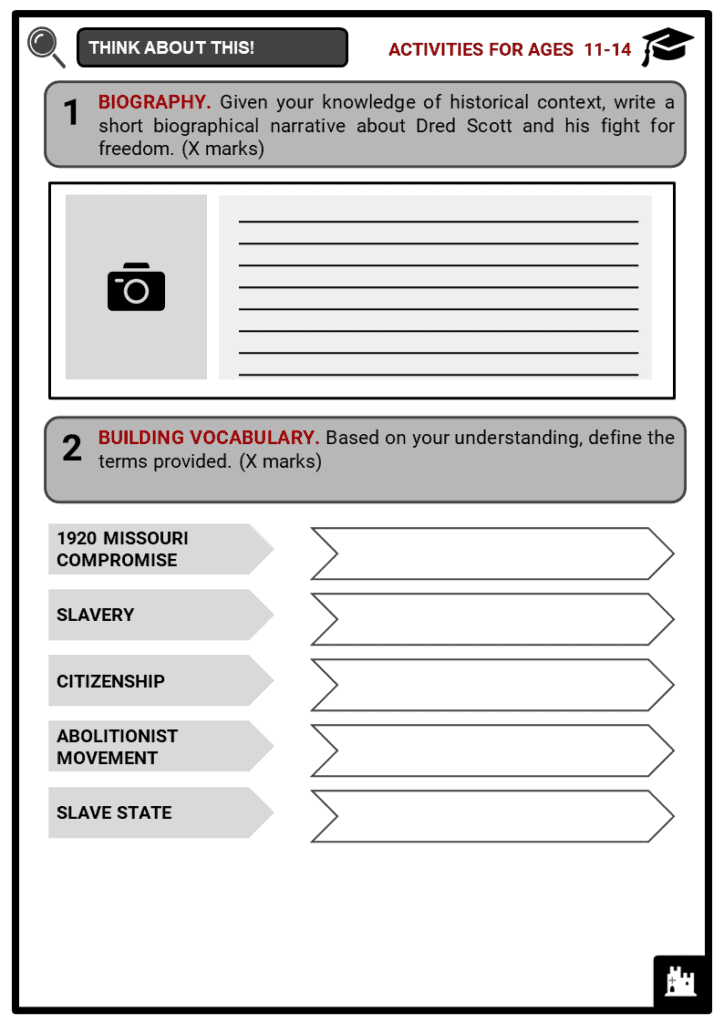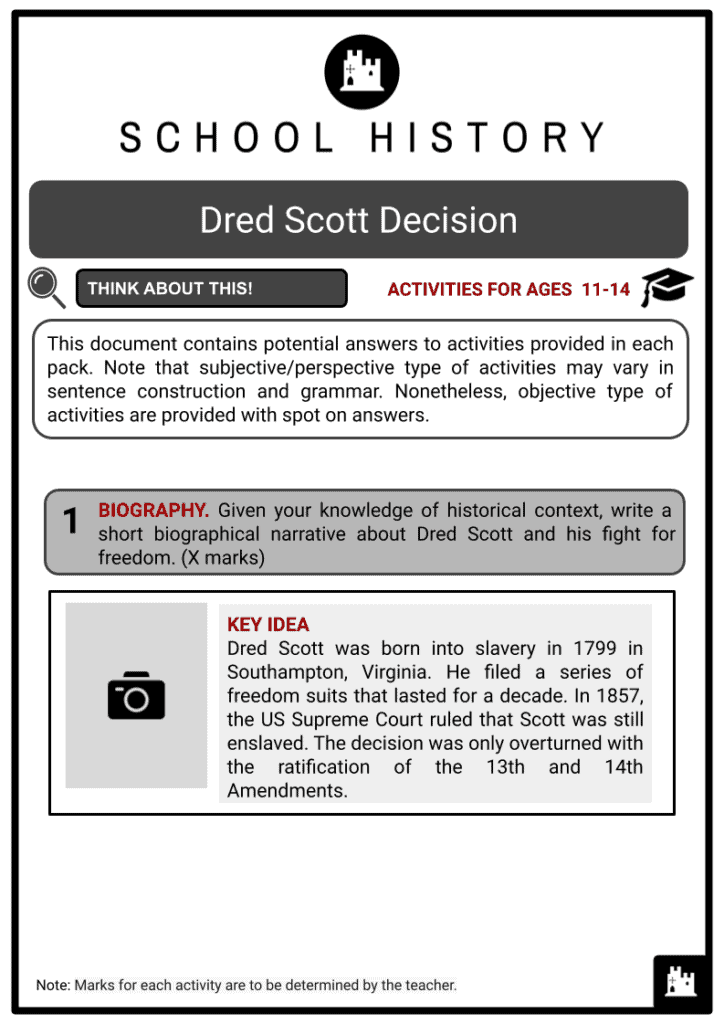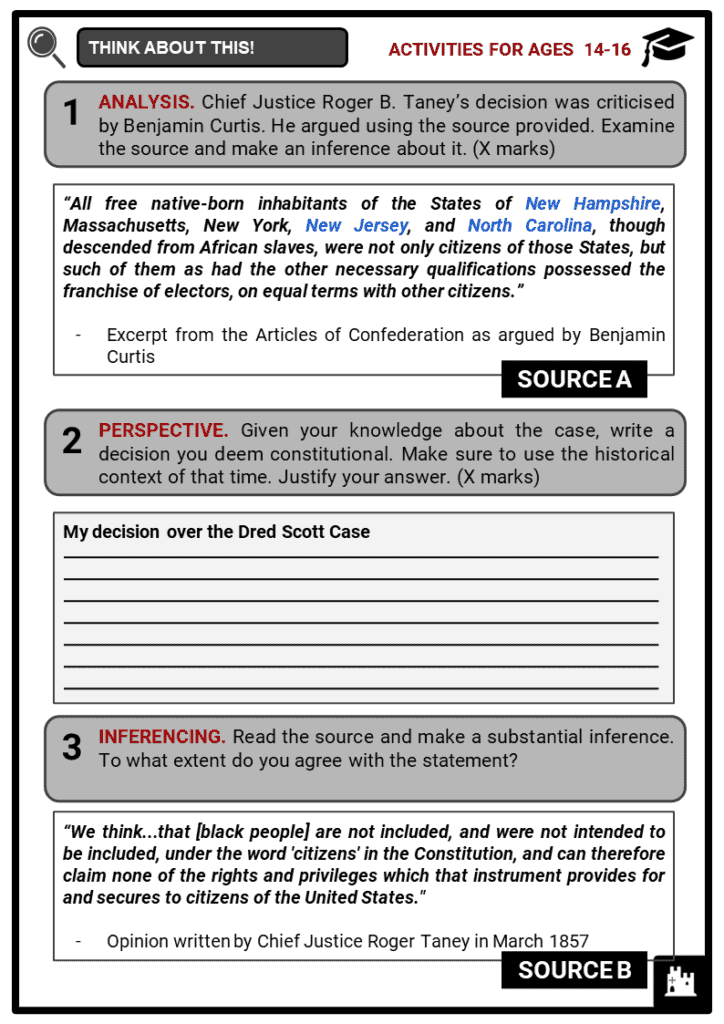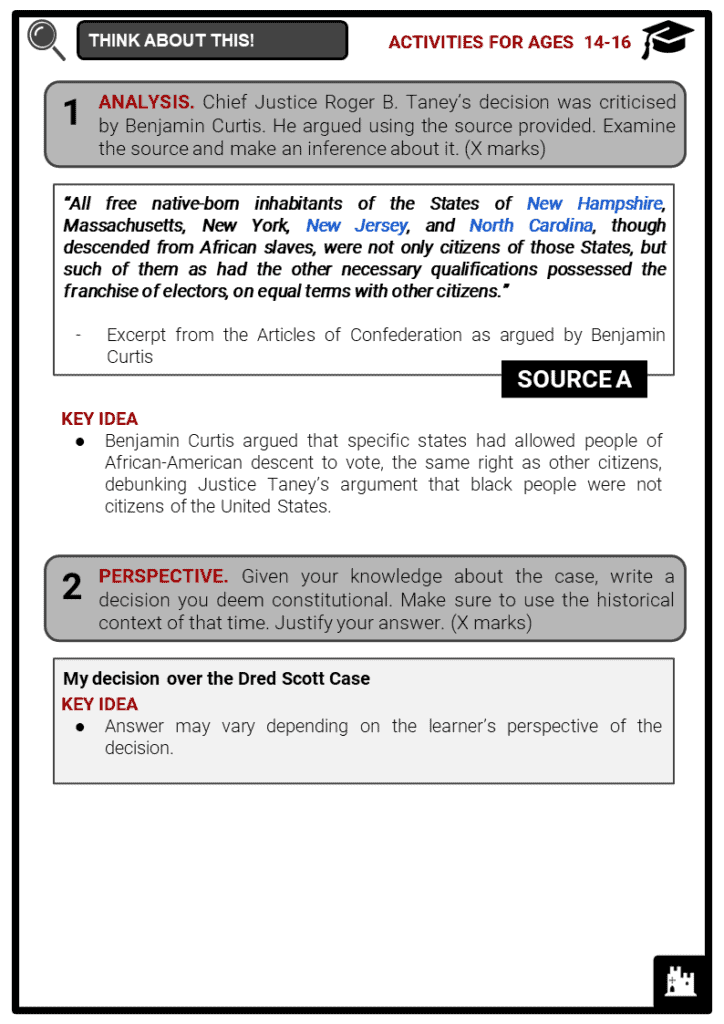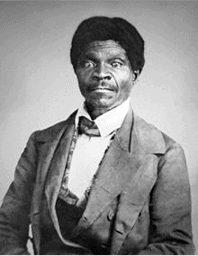Download Dred Scott Decision Worksheets
Do you want to save dozens of hours in time? Get your evenings and weekends back? Be able to teach the Dred Scott Decision to your students?
Our worksheet bundle includes a fact file and printable worksheets and student activities. Perfect for both the classroom and homeschooling!
Table of Contents
Add a header to begin generating the table of contents
Summary
- Background of the Dred Scott case and the series of freedom suits
- Brief historical context of the 1820 Missouri Compromise
- Result and Impact of the Dred Scott Case
Key Facts And Information
Let’s know more about the Dred Scott Decision!
- Also known as Dred Scott v. Sandford, the case of an enslaved African suing for his freedom lasted a decade. In 1857, the Dred Scott decision confirmed the legality of slavery in the southern states and the westward expansion, but the abolitionist movement convinced southerners that the north was bent on dismantling the institution of slavery. The suit also found that the Missouri Compromise of 1820 that declared all territories west of Missouri and north of latitude 36°30’ as free land, was unconstitutional.
Background of the case
- Dred Scott was born into slavery in 1799 in Southhampton, Virginia. He moved with his enslaver, Peter Blow, to Alabama. By 1830, Scott had moved to St Louis, Missouri. Both Alabama and Missouri were slave states.
- Two years later, Blow died, and Scott was bought by Dr John Emerson, who later moved him to Illinois and to Wisconsin territory - where slavery was outlawed under the Missouri Compromise.
- While in Wisconsin, Scott married Harriet Robinson - also an enslaved - whose ownership was transferred to Emerson.
- In 1837, Emerson met and married Eliza Sanford when he moved to Louisiana, a slave state.
- After several months, Scott followed Emerson. By October 1838, the Emersons and their enslaved people had returned to Wisconsin.
- In 1843, John Emerson died in Iowa. His enslaved people became his wife’s property. When Sanford returned to Missouri, he denied Scott was buying his freedom.
- Dred and Harriet Scott filed lawsuits against Irene Sanford in April 1846. Under two Missouri statutes, (1) Any person of any colour is allowed to sue for wrongful enslavement, and (2) Any person taken to a free territory would gain freedom and could not be subjected to slavery if returned to a Slave state.
- The Scotts received support from abolitionists, churchmates and the Blow family, who once enslaved Dred.
Brief historical context of the 1820 Missouri Compromise
- Following Thomas Jefferson’s Louisiana Purchase, members of Congress attempted to pass policies over territorial expansion and the institution of slavery. In 1820, Missouri’s application for statehood as one of the slave states caused great debate.
- Under the Missouri Compromise, Congress agreed to admit Missouri as a Slave state and Maine as a Free state. In this case, the balance in Congress remained stable. At the same time, this law prohibited slavery in Louisiana north of the 36° 30´ latitude line.
- It was signed into law by President James Monroe on 3 March 1820.
The series of freedom suits
- After his failure to purchase his freedom, Dred Scott filed a freedom suit in St. Louis Circuit Court in 1846. The following year, they were defended by Charles D. Drake. Judge Samuel M. Bay initially ruled against Scott. However, the case was reopened in 1850.
- In 1852, Mrs. Emerson filed an appeal to the Missouri Supreme Court. Chief Justice Hamilton R. Gamble favoured Emerson and made a dissenting opinion.
- The following year, Scott filed another freedom suit under federal law. By this time, Irene Emerson was residing in Massachusetts, while Scott was transferred to Emerson’s brother, John Sanford, who was a citizen of New York.
The Supreme Court Decision
- On 11 February 1856, Scott’s trial reopened after his appeal to the US Supreme Court. The following year, he lost his fight for freedom. Chief Justice Roger Taney ruled under 3 major points.
- According to the U.S Constitution, any person descended from Africans, whether enslaved or free, is not a citizen of the United States.
- Freedom or citizenship within the Northwest territory of non-white people cannot be conferred by the Ordinance of 1787.
- The provisions of the 1920 Missouri Compromise have been voided since they exceeded the power of the Congress.
- The US Supreme Court particularly ruled that African-American descendents had no claim to freedom because they were not considered citizens in the first place, and thus had no legal rights to sue in a federal court.
- Moreover, he justified that under the Fifth Amendment, enslaved people were the legal property of their enslavers.
- Scott’s legal fees were initially supported by Peter Blow’s children. After the Missouri Supreme Court decision, Roswell Field represented Scott pro bono.
- Montgomery Blair represented Scott before the US Supreme Court.
- Also, according to Taney, the doctrine of popular sovereignty under the 1854 Kansas-Nebraska Act was unconstitutional. He particularly voided the principles of territorial sovereignty, free soil and any antislavery arguments.
- Taney’s ruling was criticised by two justices, John McLean of Ohio and Benjamin Curtis of Massachusetts.
Impact of the Decision
- The decision, made on 6 March 1857 further heightened tensions on the issue of slavery. For the US Supreme Court, Scott was still enslaved. Pro-slavery states supported the decision and believed it was a devastating blow to the abolitionists.
- For many, the Dred Scott decision became a landmark case on the issue of slavery and the government’s stand on it.
- The decision also made the 1920 Missouri Compromise unpopular. Southern enslavers accused Northerners as enemies of the Union for supporting the Abolitionist Movement.
- Prior to the decision, neither Congress nor the President had failed to resolve the issue of slavery. So when the last branch of the government, the Supreme Court, ruled on the case, Southerners felt that they were constitutional all along and wished to expand slavery.
- Historians agreed that the case decision contributed to the growing national divisiveness in the United States that later led to the Civil War in 1861. It was utilised during the Lincoln-Douglas debates in 1858.
- The Supreme Court’s decision was legally overturned with the ratification of the 13th and 14th Amendments during the Reconstruction period.
- On 31 January 1865, the 13th Amendment legally abolished slavery in the United States. Whilst the 14th Amendment granted citizenship to all persons born or naturalised in the United States.
Significant opinion and later references
- Dred Scott ... rested upon the concept of "substantive due process" that the Court praises and employs today. Indeed, Dred Scott was very possibly the first application of substantive due process in the Supreme Court, the original precedent for... Roe v. Wade - Justice Antonin Scalia
- Lincoln goes for warfare upon the Supreme Court of the United States, because of their judicial decision in the Dred Scott case. I yield obedience to the decisions in that court—to the final determination of the highest judicial tribunal known to our constitution. - Douglass during his debate against Lincoln
Image sources:

